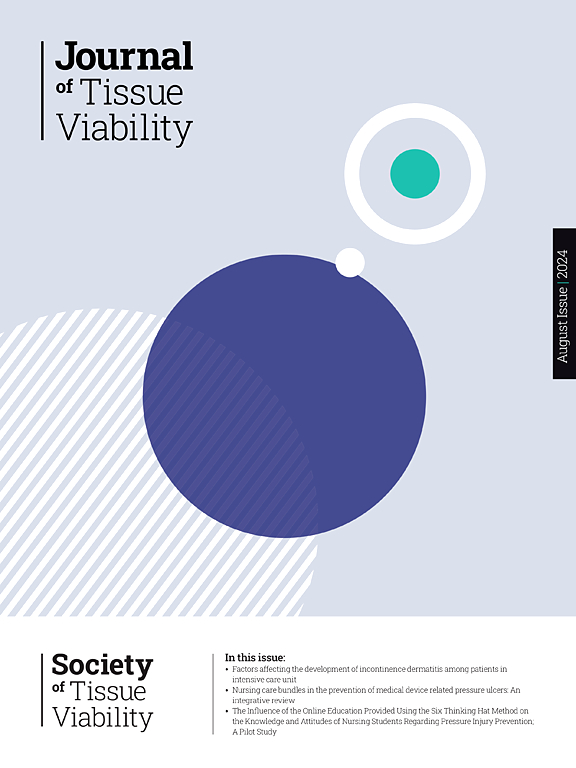热成像能否预测糖尿病患者的糖尿病足溃疡风险?系统综述。
IF 2.4
3区 医学
Q2 DERMATOLOGY
引用次数: 0
摘要
背景:糖尿病足溃疡(DFU)在糖尿病患者中的发病率越来越高,热成像技术的使用引发了人们对一种用于早期DFU风险评估和管理的无创诊断方法的兴趣:方法:2023 年 4 月,使用 MEDLINE、CINAHL 和 Cochrane 数据库对出版物进行了系统检索,并对相关文章进行了综述。提取数据并进行叙述性综合。循证图书馆学(EBL)检查表评估了所纳入研究的方法学质量。通过审查这些文章,得出了本次文献综述的主要和次要结果。主要结果侧重于热成像对 DFU 的预测能力,次要结果则评估热成像的可行性、可用性和有效性:结果:1994 年至 2021 年期间进行了八项研究,重点关注热成像技术在预测 DFU 风险方面的可预测性。所有八项研究都侧重于与 DFU 发展相关的温度变化。其中六项研究比较了糖尿病患者使用 DFU 和不使用 DFU 的效果。总体结果显示,在预防 DFU 的过程中使用热成像技术可实现早期检测和干预,为降低糖尿病患者发生 DFU 及其相关并发症的风险提供了一种非侵入性的有效手段:系统综述表明,热成像技术在预测 DFU 风险方面大有可为,相关研究显示了其预测能力和对患者的益处。尽管存在一些挑战和局限性,但有证据表明热成像技术在评估糖尿病患者的 DFU 风险方面具有价值,因此有必要对设备类型和位置进行进一步研究。本文章由计算机程序翻译,如有差异,请以英文原文为准。
Can thermography predict diabetic foot ulcer risk in patients with diabetes mellitus? A systematic review
Background
There is a growing prevalence of diabetic foot ulcers (DFUs) in patients with diabetes mellitus and the use of thermography has sparked interest in a non-invasive diagnostic method for early DFU risk assessment and management.
Aim
This systematic review aims to assess the use of thermography in predicting diabetic foot ulcer risk in patients with diabetes mellitus.
Methods
A systematic search of publications using MEDLINE, CINAHL, and Cochrane databases was conducted in April 2023, and relevant articles were reviewed. Data was extracted and a narrative synthesis was undertaken. The evidence-based librarianship (EBL) checklist assessed the methodological quality of the studies included. Reviewing these articles to the primary and secondary outcomes of this literature review. The primary outcome focused on the predictive capabilities of thermography for DFU prediction, while the secondary outcome assessed the feasibility, usability, and effectiveness of thermography.
Results
Eight studies were conducted from 1994 to 2021 with an emphasis on the predictability of thermography in predicting DFU risk. All eight studies focused on temperature variations associated with DFU development. Six of the included studies compared the effectiveness of DFU occurrence in diabetic patients and non-DFU use. The overall results showed that employing thermography in DFU prevention might allow for early detection and intervention, offering a non-invasive and effective means to reduce the risk of DFU development and its associated complications in patients with diabetes mellitus.
Conclusion
The systematic review indicates that thermography holds promise for predicting DFU risk, with studies showcasing predictive capabilities and patient benefits. Despite some challenges and limitations, the evidence suggests thermography's value in assessing DFU risk in diabetes patients, warranting further research on device types and locations.
求助全文
通过发布文献求助,成功后即可免费获取论文全文。
去求助
来源期刊

Journal of tissue viability
DERMATOLOGY-NURSING
CiteScore
3.80
自引率
16.00%
发文量
110
审稿时长
>12 weeks
期刊介绍:
The Journal of Tissue Viability is the official publication of the Tissue Viability Society and is a quarterly journal concerned with all aspects of the occurrence and treatment of wounds, ulcers and pressure sores including patient care, pain, nutrition, wound healing, research, prevention, mobility, social problems and management.
The Journal particularly encourages papers covering skin and skin wounds but will consider articles that discuss injury in any tissue. Articles that stress the multi-professional nature of tissue viability are especially welcome. We seek to encourage new authors as well as well-established contributors to the field - one aim of the journal is to enable all participants in tissue viability to share information with colleagues.
 求助内容:
求助内容: 应助结果提醒方式:
应助结果提醒方式:


